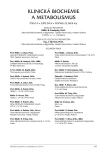Quality requirements for the determination of glycated hemoglobin HbA1c and possibilities of its application for diagnostic purposes
Authors:
B. Friedecký; J. Kratochvíla
Authors‘ workplace:
SEKK s. r. o. Pardubice
Published in:
Klin. Biochem. Metab., 22 (43), 2014, No. 3, p. 127-131
Overview
We introduce the brief review of the requirements for analytical quality in HbA1c, created by important guidelines, experts’ meanings, and used in well known external quality assessment programs. Namely requirements on the precision, bias and total errors are showed. Information on the quality of laboratories and often frequented methods are here too. Very interesting are data about requested and provided frequency of control measurements. On the basis of introduced results we can presume higher quality of HbA1c measurement in world than in the Czech republic, maybe due to these higher required frequency. Very important role can play the fact of using HbA1c not only as therapy, but also diagnostic marker in diabetes. This aspect of diagnostic using the HbA1c is currently not present in the Czech republic. Comparison of our situation in POCT performance with Norwax reality clearly shows that situation in the Czech republic is not under control.
Keywords:
HbA1c, precision, bias, frequency of control analysis, POCT.
Sources
1. Solvik, U. O., Roraas, T., Christenson, N. G., Sandberg, S. Diagnosis Diabetes Mellitus: Performance of Hemoglobin A1c Point-Of-Care Instruments in General Practice Offices. Clin. Chem. 2013, 12, p. 1790-1801.
2. Aslan, B., Gun-Munro, J., Flynn, G. J. Role of proficiency testing in monitoring of standardization of hemoglobin A1c methods. Accred. Qual. Assur., 2012, 17/4, p. 419-424.
3. Mosca, A., Lapolla, A., Gillery, P. Glycemic control in the clinical management of diabetic patients. Clin. Chem. Lab. Med., 2013, 51, p. 753-766.
4. John, W. G. Expert position statement. Use of HbA1c in the diagnosis of diabetes mellitus in the UK. The implementation of World Health Organization Guidance 2011. Diabet. Med., 2012, 29, p. 1350-1357.
5. Sacks, D. B., Arnold, M., Baktris, G. L., Bruns, D. E., Horvath, A. R., Kirkman, M. S. et al. The guidelines and recommendations for laboratory analysis in the diagnosis and management of diabetes mellitus. Clin. Chem., 2011, 57, E1-47.
6. Weykamp, C., Mosca, A., Gillery, P., Panteghini, M. The analytical goals for hemoglobin A1c measurement in IFCC units and National Glycohemoglobin Standardization Program units are different. Clin. Chem., 2011, 57, p. 1204-1206
7. Friedecký, B., Kratochvíla, J. SKUP – cesta ke zvýšení kvality péče o pacienty. Prakt. Lék., 2012, 92 (10), p. 492-495.
Labels
Clinical biochemistry Nuclear medicine Nutritive therapistArticle was published in
Clinical Biochemistry and Metabolism

2014 Issue 3
Most read in this issue
- Comparison of creatinine clearance and estimated glomerular filtration rate in patients with chronic kidney disease
- Unification and validation of reference intervals – pilot study
- Quality requirements for the determination of glycated hemoglobin HbA1c and possibilities of its application for diagnostic purposes
- Positive association of adiponectin with adipocyte fatty acid binding protein in patients with unfavourable dyslipidemic phenotype
